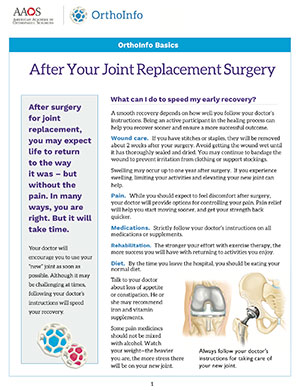Finger Joint Replacement
![]() In a normal joint, bones have a smooth, glistening surface made of a substance called articular cartilage on their ends that allows one bone to glide easily against another. Joints are lubricated by a thin layer of synovial fluid that acts to keep moving parts gliding smoothly. When the articular cartilage wears out or is damaged or the joint fluid is abnormal, problems develop and joints often become stiff and painful, resulting in arthritis. This basic problem is the same in all types of arthritis - the joint surfaces are worn out or not moving properly. In some cases, it may be possible to treat arthritic joints surgically, including joint replacement by a board certified hand surgeon.
In a normal joint, bones have a smooth, glistening surface made of a substance called articular cartilage on their ends that allows one bone to glide easily against another. Joints are lubricated by a thin layer of synovial fluid that acts to keep moving parts gliding smoothly. When the articular cartilage wears out or is damaged or the joint fluid is abnormal, problems develop and joints often become stiff and painful, resulting in arthritis. This basic problem is the same in all types of arthritis - the joint surfaces are worn out or not moving properly. In some cases, it may be possible to treat arthritic joints surgically, including joint replacement by a board certified hand surgeon.
In a joint replacement, the abnormal bone and lining structures of the joint are removed surgically, and new parts are inserted in their places. These new parts may be made of special metal, plastic, or specific kinds of carbon-coated implants. The new parts allow the joints to move again with little or no pain.
 What kind of joints can be replaced?
What kind of joints can be replaced?
- Finger joints (the “first” joint, called the PIP joint)
- Knuckle joints (called MP joints, where the finger joins the hand)
- Wrist joints
Artificial joints should not be done if you have:
- An infection in the joint
- Muscles or tendons that normally would move the involved joint are damaged and cannot be repaired, allowing a new joint to work properly
- Other joint replacements or hardware from other surgeries that would block insertion or motion of a new implant
- Problems with skin or bone quality
What are the benefits of joint replacement surgery?
- Reduce joint pain
- Restore or maintain joint motion
- Improve the look and alignment of the joint
- Improve overall hand function
What are the risks of joint replacement surgery?
- Implant loosening, fracture or wear that occurs over time and which may require subsequent surgery to repair or replace the damaged parts Infection
- Joint stiffness or pain, if the procedure or implant fails
- Dislocation of the artificial joint
- Damage to vessels, nerves or other structures in the region of the surgery
Therapy supervised by a trained hand therapist is almost always required after any joint replacement surgery, usually for several months. Special splints are generally used depending on which joint was replaced and how the surgery was performed.
Click here to learn more about getting ready for joint replacement.

